
Celebrating Ukrainian Easter: Not Rabbits and Chocolate but Paska and Pysanky
Ethnologist Ihor Poshyvailo Explains Christian and Pagan Elements of Ukrainian Easter, with Oksana Smerechuk

Hromadske Radio is independently funded. We are appealing for funds through a crowd funding initiative. Should you feel inclined to donate, you can do so here using Wayforpay.
Hello, this is Ukraine Calling with Oksana Smerechuk. This is the final week before Easter. My thoughts are about how Ukrainians celebrate Easter. With me in this studio I have a very interesting ethnologist Ihor Poshyvailo, PhD, a Fulbright scholar at the Smithsonian Institute, and also former deputy director of the Ivan Honchar Museum, a Ukrainian national centre of folk culture. At the moment he is Director General of the National Memorial Museum of Maidan. Welcome!

Poshyvailo: Hello.
Smerechuk: Nice to have you here.
Poshyvailo: Thank you so much for inviting me.
Smerechuk: As I walk around the streets in Kyiv. I do not see really many chocolate Easter eggs, which is something you would expect, let’s say, in Canada, US or Western Europe. What do you expect how Ukrainians preparing to celebrate Easter?
Poshyvailo: Easter is a special holiday for Ukrainians. It has some special features and you can easily distinguish it from traditions in the east like in Russia and from the west like Western Europe and US. Maybe the most typical feature is that it is a family holiday and the most explicit, vivid attributes of this celebration are Easter eggs, special, unique…
Smerechuk: But not chocolate ones…
Poshyvailo: And no rabbits at all. And of course handmade “Paska” [a traditional Ukrainian Easter Bread]. Many families even in big cities bake “Paska.” It is not only an attribute. It is a special symbol. Usually, according to our tradition people have to bake Paska at home with the family. Even in a rural tradition we still have so many connections to the past. For many centuries baking Paska and bringing it to the church for blessing was a special event. I know from many fieldtrips and expeditions to villages when we tried to find out how the process was in our recent past, many people tried to bake a Paska as big as possible. Sometimes in these home stoves people had to take down some upper parts of the stove because with a Paska you can easily put it inside, but can hardly take it outside, because when baking process goes correctly can be twice big the original size. Usually people were in a hurry to bring this Paska to the church to be the first. It was like a competition.
Smerechuk: So you would say that baking this Easter bread, or Paska, is the central symbol of the holiday?
Poshyvailo: Paska and Easter eggs. Today we have transformations because painting Easter eggs – pysankas – is becoming much more of a decorative process. On the one hand people mostly accept them as an attribute of Easter. On the other hand, it is kind of decorative art. It is losing its symbolic tradition. Even in the past two types of eggs were used. One was empty and the other was full.
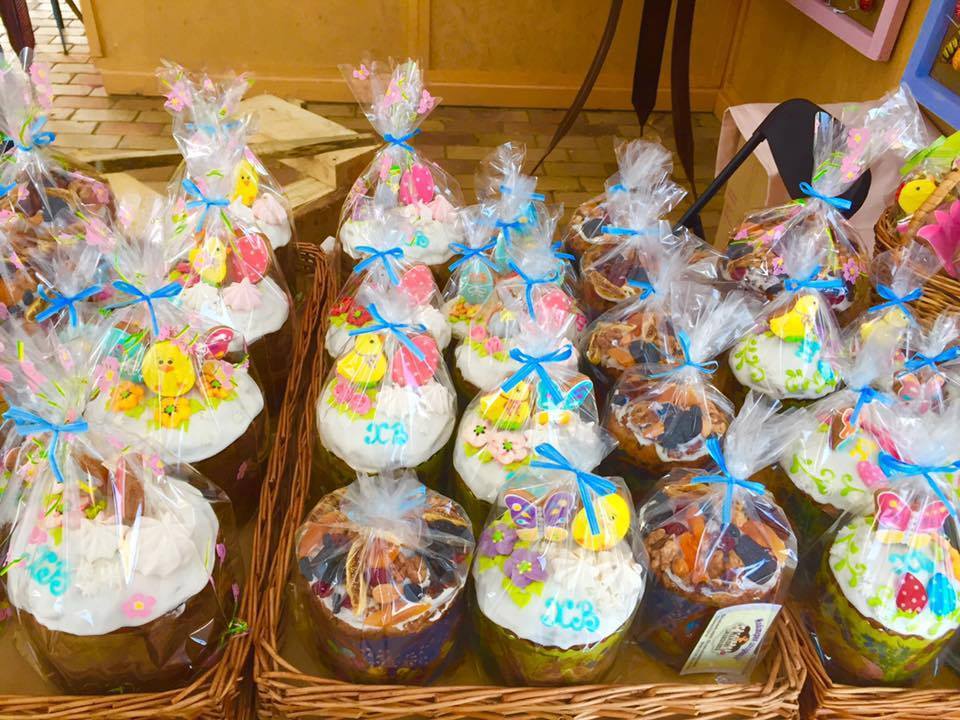
Smerechuk: You mean the ones that you blow out?
Poshyvailo: Yes.
Smerechuk: And raw eggs.
Poshyvailo: Yes. People mostly brought empty pysankas to cemeteries, to the dead, because…
Smerechuk: So they would bring a painted egg as a gift.
Poshyvailo: Yes. It was a part of the Easter celebration.
Smerechuk: Was it before or after Easter?
Poshyvailo: After. In some regions immediately after Easter. It is called the ‘dead people remembrance week.’ One week after, mostly on Saturday or Sunday. In some villages and regions you have Monday a special day. Today this tradition is getting much wider. You can see decorated cemeteries with people bringing to cemeteries flowers, eggs, and Paskas. Usually people bring empty pysankas to the dead.
Smerechuk: Why this attention is paid to cemeteries just right after Easter? Is it tied to Resurrection?
Poshyvailo: Easter has quite deep traditions. In Ukraine it is still a combination of pagan pre-Christian traditions and Christian traditions. Usually we speak about three connotations of this holiday celebration. It can be celebration of fertility. As a symbol of fertility people would put a pysanka in the land when ploughing.
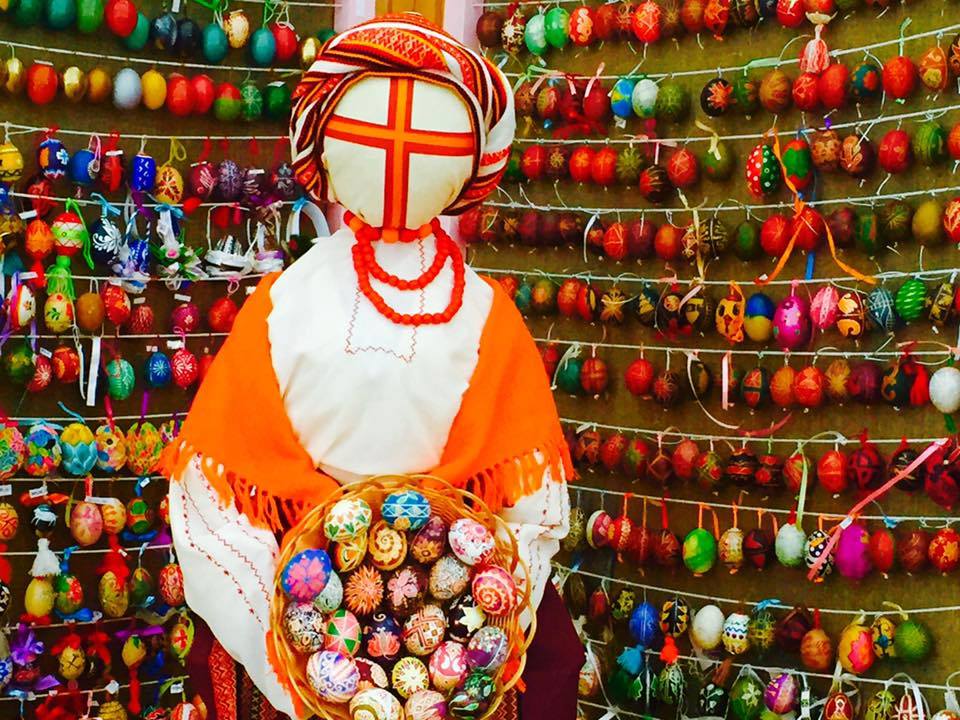
Smerechuk: I guess as symbol of planting the life.
Poshyvayo: Trying to guarantee a great harvest. On the other hand, it is a pre-Christian symbol, with ornamentations of the universe, archetypal symbols like the tree of life, solar and lunar symbols.
Smerechuk: There is a lot there.
Poshyvailo: And the third connotation is of course Christian – Resurrection.
Smerechuk: Going back like someone has never been to Ukraine before, what would say expect? How do the events develop? Does it start with lent? Is there special rituals for lent? You are supposed to fast, right?
Poshyvailo: When a foreigner would come to the streets of Kyiv, there is nothing special to see how people fast.
Smerechuk: But you can see it in restaurants. You have special vegetarian, no meat, possible no diary menus for lent.
Poshyvailo: In supermarkets you have a lot of products for fasting. You can see for fasting even so-called mayones. It is quite funny.
Smerechuk: Do you think a lot of people fast?
Poshyvailo: A lot of people fast. And I know a lot of young people here in the urban environment in Kyiv. Young, absolutely modern people are fasting. Fasting is great is not only due to Christian tradition. A lot of people still get to idea it is good for health.
Smerechuk: It’s a cleansing…
Poshyvailo: Right. It is becoming fashionable, because young people want to be special in different ways. Fasting is also testing your mental, psychological strength. It makes you kind of a special person, because on the one hand you celebrate old traditions, you care about your mental and physical state. On the other hand, it is great to have the final point. When you fast, you can feel the celebration much better.
Smerechuk: So during the lent period there is no meat, no diary, no parties, no music. So this is like a blueprint of a classical traditional model of celebration of Easter. 40 days of lent and then …
Poshyvailo: No parties usually, no dancing…
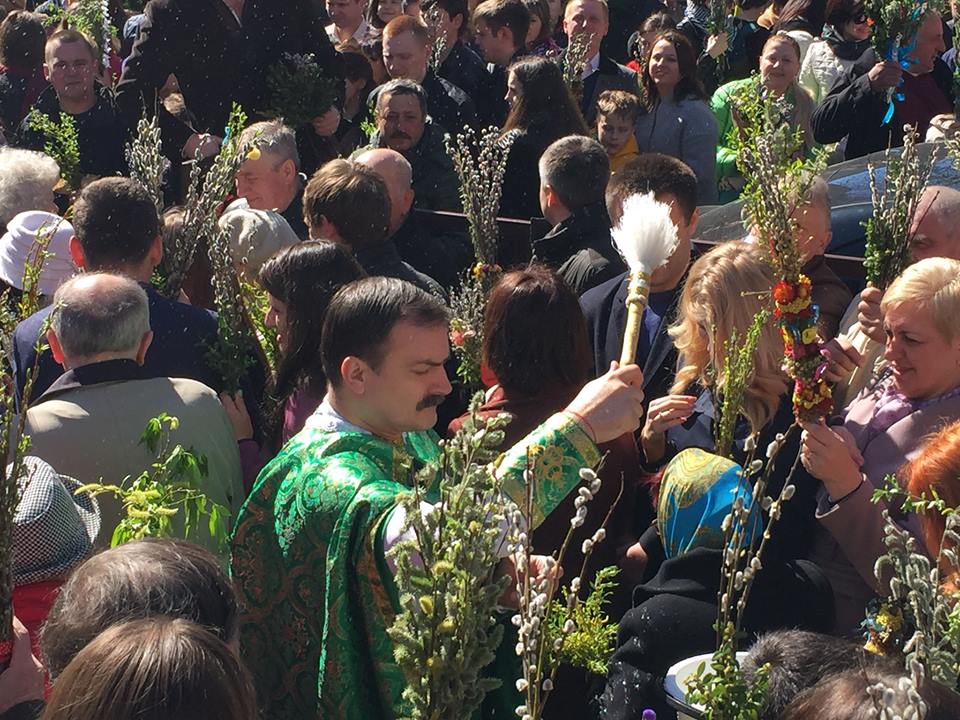
Smerechuk: You have these 40 days of lent and then you have the Easter service (which is Easter Saturday, through the night) and the Easter service ends with the celebration of the Resurrection on Easter Sunday. And that’s when you break the fast, right?
Poshyvailo: Many people stay at churches during the night ceremonies, and the churches in Kyiv are overcrowded in this period. You can hardly enter inside, so even before midnight many people stay around the church. There are special baskets with not only pysankas, painted eggs and Paskas, but also with wine and sausage…
Smerechuk: I am surprised – wine?
Poshyvailo: Yes, it is a modern transformation. Because people still believe that the food which is blessed on this special day will bring some good health. And they try even to bless the main attributes of the celebration during breakfast and dinner for the next day. So they try to bring products for the feast table.
Smerechuk: So, this sounds to me like it is a modern tradition to have wine in the basket, because as I understand, the classic traditional food should be the Easter bread, boiled eggs and also butter, which is one of the foods that were forbidden during the fast, some meat…
Poshyvailo: Salt…
Smerechuk: Yes, salt, and horse radish. So, these are the classic foods, and cheese, of course. But this is, I guess, is something new that you can have wine?
Poshyvailo: Wine and horilka [vodka] and different kinds of sausages, meat. Because for people who really kept the fast, it is a special day. It is not 40 days, it is, in fact, 7 weeks. And so for people who kept fasting, it is a special day to celebrate on different levels. People are so joyful and especially in villages, where tradition is still alive. They exchange food – Paskas and pysankas – and they fight with pysankas…
Smerechuk: Oh, they try to compete, whose egg is the stronger.
Poshyvailo: The person whose egg is stronger will dominate in the family for the coming year. Whose final decision will be accepted in the family. On the other hand, fighting with eggs is also an old tradition. A hundred years ago, or so, it became mainly for children. But earlier than that, according to some beliefs, people believed that with painted eggs it was possible to manipulate demons, evil forces. By rotating these painted eggs it was possible to control the behavior of these evil forces. So, it was kind of a game and an attempt to persuade people that they could be over, stronger than evil forces.
Smerechuk: You are talking a lot about these beliefs that I think go back a long way, this is more than a hundred years probably. What’s interesting, I find in Ukraine, it’s like for about 70 years, or 40-50 years in one part of the country, officially there was no Easter. During the Soviet times it was banned. Do you have any memories of this time, of Easter celebrations?
Poshyvailo: Maybe this is one reason why this tradition is enjoying such a revival, importance, and scale. Because in Eastern Ukraine it was forbidden and even the Soviet authorities tried to fight against these old traditions. And I remember while studying in Soviet school, the so called ‘subotnyky’, special working days, which were organized on the Saturday before Easter. According to tradition it was a big sin to work on Easter and before Easter, because you have special days to make Paskas. And it was really a big harm to Ukrainian traditional culture, for consciousness, for world outlook. And before Easter so many churches were ruined. And I know my grandmother told me a story that those, so- called, Komsomol activists, who were in front rows to destroy churches, to take down crosses from domes, were punished later on by some problems in family, health of their children. So, it was a double standard situation, because people were forbidden in general – in schools, especially teachers, my grandmother was a teacher. It was very hard for her when a director of school…
Smerechuk: So, she could not go to the church and bless a basket with Easter foods?
Poshyvailo: Not even her, but she was obliged to control her class, school children…
Smerechuk: To check.
Poshyvailo: To check, she had to check, that people do not go to church. Officially churches in Soviet period were open, but everything what was going on inside was controlled – in Eastern Ukraine, in Central Ukraine. In Western Ukraine this tradition was much stronger and the tradition was still kept alive there. And I remember that my grandparents were very connected to Ukrainian culture, to folk traditions. And one of my grandmothers was famous Ukrainian poetess from Opishne, a capital of Ukrainian ceramics. And I remember when I visited her 35 years ago, I was 14 years old, I never remember a celebration of Easter in that period. So, it was forbidden. Maybe among themselves people tried to keep it sometimes, they painted eggs, but it was in a secret way.
Smerechuk: Something done privately. So what happened then in the 1990s? How did the Easter revival begin? And what do you remember that what was different about the celebrations in the 1990s and celebrations today?
Poshyvailo: When Ukraine renewed its independence in 1991, it was a big wave of national revival movement in different ways and in different fields, especially in religion. A lot of churches were reconstructed. A process started, some people think it was crazy to build so many churches in villages. But really in the situation, say my native village which my parents are from, had 10 thousand people living there at that moment. And there were 8 churches, big churches, gold-domed cathedrals. It was quite normal that people, when they got freedom, they started to revive their traditions and religion. The Ukrainian Autocephalous Church was renewed after being repressed during the Stalin times. And of course this revival movement created glorifications, celebrations. People tried to use every moment, every holiday, especially religious holiday, to celebrate their identity, their national and cultural traditions. And still in many ways, in language, in culture we have seen some peaks and downfalls, but in this religious reliability it goes up and up. In Kyiv, as I mentioned, churches are overcrowded.
Smerechuk: Would you say it is becoming more commercial? Do you think business in general is taking the opportunity to make some money somehow of Easter? Are products for Easter more available?
Poshyvailo: Well yes, of course. Easter celebrations are becoming much more commercialized. On the one hand, it’s not good. From the other side, it’s okay.
Smerechuk: Well, it’s because it’s all available. You don’t have to make it yourself at home, I guess.
Poshyvailo: If we speak about the possibility to buy Paskas everywhere: the market, supermarkets, everywhere. I think it’s good. On the other hand, we have seen so many stickers, which are not connected to Ukrainian tradition, it’s something from –
Smerechuk: I love that tradition.
Poshyvailo: We see rabbits, they ruin our tradition because we have a definite, special, unique, limitations or symbols with painting pysanka. You can paint it in the special liquid prepared from onion, they become golden and brown, and very simple.
Smerechuk: Yes, it’s the traditional way to use natural dyes.
Poshyvailo: Natural dyes, not refined decoration, but all the stickers which are plastic, which in fact, is not very ecological. I don’t like this innovation, but having the possibility to buy Paskas everywhere, and most are very high quality, is great.
Smerechuk: So, if I was a foreigner, say, or someone visiting Ukraine for the first time, and I wanted to experience Easter – the best parts of it – what would you recommend particularly in Kyiv, where to go, what to see?
Poshyvailo: I would recommend before Easter day, trying to participating in master classes, in painting Easter eggs or baking Paska. During Easter, I would suggest to go to church before midnight. It’s a special performance, it can be, for foreigners. You can see a lot of people, a lot of candles around the churches, especially with the (Bezkiy Monstistery), St. Volodymyr Cathedral, Kyiv Pecherska Lavra. Overcrowded, a lot of people with their baskets nicely decorated, nicely dressed. It’s a great performance for outsiders. On the other hand, I would recommend, as I mentioned, the master classes. For example, our museum organized baking Paskas and painting Easter eggs for the Heavenly Hundred heroes [protesters killed by snipers in the final days of the Euromaidan protests] and for the soldiers fighting in Donbas.
Smerechuk: A special event?
Poshyvailo: A special event, yes. It’s a kind of participator events, you can be a part of, and you can not only celebrate, but also be relevant in Ukraine today. You can organize a celebration for people who are in a different situation, who are at the front. These kind of possibilities you can find a lot in Kyiv because a lot of volunteers, museums, cultural institutions, public organizations organize such events today.
Smerechuk: Of course, and then you can go, I think to the Andriyivskyi Uzviz, and as many places you can buy souvenir eggs, painted eggs, Ukrainian style. But I think the nicest ones I’ve seen were at the Ivan Honchar Cultural Center, you had a little Easter market.
Poshyvailo: Yes, and I would also recommend visiting a lot of exhibitions which are devoted to this special event, mostly museums, art galleries, open thematic exhibitions and on the St. Sophia square. You can also see modern pysanka installation – huge pysankas, lots of them – like last year also, it’s becoming a tradition in Kyiv and they’re becoming –
Smerechuk: So, they are not actually real eggs?
Poshyvailo: No, they are huge, they may be one metre high. Lots of them are quite different, traditional, non-traditional, contemporary art. So, it’s a big installation in a very special place in Kyiv, so I would recommend to visit this event.
Smerechuk: I guess that’s an example for how the Ukrainians are adapting these traditions and developing into something bigger, something new.
Poshyvailo: Yes, and it’s also amazing how making pysanka – and the pysanka itself is a model symbol of the universe. Most of the designs are pre-Christian, and the church supports these pre-Christian traditions. In Ukraine, it’s amazing, you can see art installations in the Kyiv Pechersk Lavra [Monastery of the Caves] and many others, in St. Michael’s Cathedral as well. You can witness this unique combination of pre-Christian traditions here in modern Ukraine.
Smerechuk: Well, thank you, Ihor, for sharing you insights on how Ukrainians celebrate Easter. Without further ado, I think we have to do our own preparations for Easter. So, thank you for coming in.
Poshyvailo: Thank you for inviting me, and Happy Easter!
Smerechuk: Happy Easter to you too!
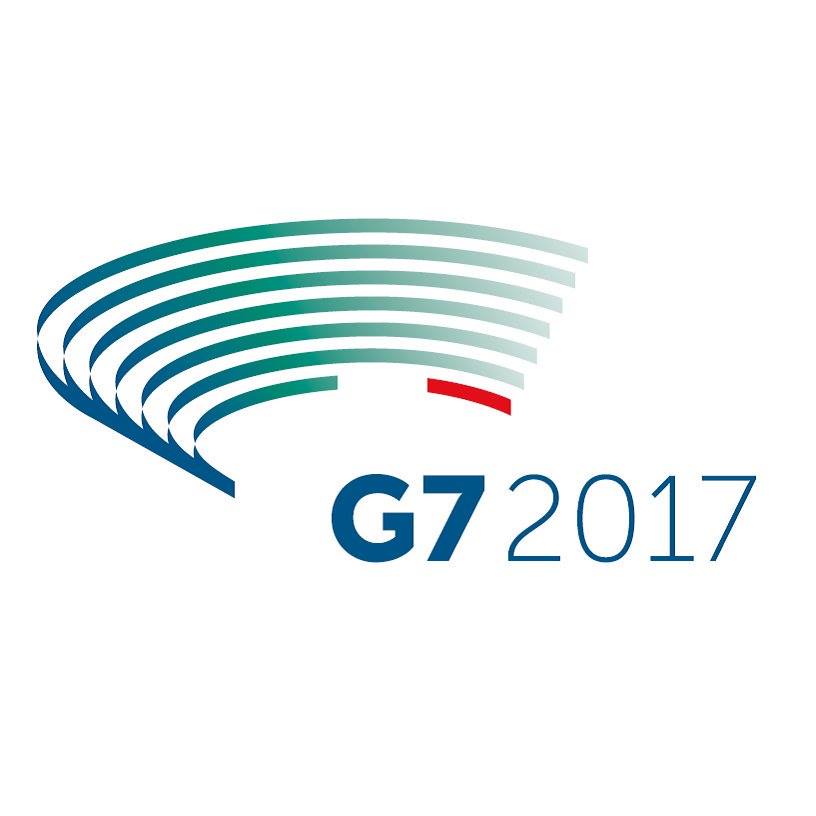
HEADLINES
G-7 Summit in Italy
Foreign Ministers of the world’s largest economies, the G7 countries, met in Italy this week. The Syrian conflict dominated the agenda in the wake of US air strikes against the Assad regime. A big part of the debates were how to pressure Russia on the Syria question. Ukraine Calling listeners will remember that Russia was kicked out of the club of industrialized nations, formerly the G8, after it annexed Crimea in 2014. Italian Foreign Minister Angeline Alfano said that there was ‘no consensus’ among the G7 countries about new sanctions against Russia for its support of Assad. But he added that ‘the G7’s position is very clear – supporting the existing sanctions’ against Russia for its activities in Ukraine. Leaders of the G7 countries will meet in Italy at the end of May, and it will likely be Donald Trump’s first overseas visit since becoming President.

Tillerson goes to Moscow
US State Secretary Rex Tillerson was at the G7 Summit. On the first day he said, “We rededicate ourselves to holding to account any and all who commit crimes against the innocents anywhere in the world.” But in a later remark he asked, “Why should US taxpayers be interested in Ukraine?” Earlier in the week he told an ABC TV interviewer, “There’s been no change of the status of the situation in Ukraine or Crimea. And those sanctions will remain in place until those issues are addressed.”
After the G7 Summit Tillerson headed to Moscow. It was the first high level US visit to Russia since Trump was elected. Tillerson met with Russian President Putin and Foreign Minister Lavrov. The topic of Ukraine did not figure prominently in the talks. In summing up his visit, Tillerson mentioned the lack of progress in adhering to the Minsk Agreements in the Donbas region as a hindrance to improving relations between the USA and Russia.
Yanukovych is Back in the Headlines, with Manafort
Ukraine’s deposed President Victor Yanukovych, and Trump’s deposed campaign chairman Paul Manafort, hit the international headlines together this week. Both men are being investigated for corruption, and now there is evidence that the two colluded. On Wednesday Associated Press reported that they have obtained records documenting that Manafort’s consulting firm received at least $1.2 million in payments from Ukraine’s pro-Russian Party of Regions. That’s Yanukovych’s former party. The payments were reportedly for a covert Washington lobbying operation, and were recorded in what is known as the “Black Ledger.” It’s a book where the Regions Party recorded off the record payments and it was discovered after Yanukovych fled to Russia. Previously, Manafort’s spokesperson had said the Ledger was fabricated. But Ukraine’s Anti-Corruption Bureau has verified the authenticity of the document. AP now says it has evidence of wire transfers that Manafort’s firm received payments of $750,000.00 and $455,249.00, which match Ledger entries. US federal prosecutors are looking into Manafort’s finances as part of a larger corruption investigation. One dimension aims to recover assets stolen from Ukraine after Yanukovych was ousted. Ukraine’s Anti-Corruption Bureau is investigating Ukrainian political figures who appear in the Black Ledger. Manafort was fired by Trump last summer, when news about his name appearing in the Black Ledger first surfaces in the New York Times.
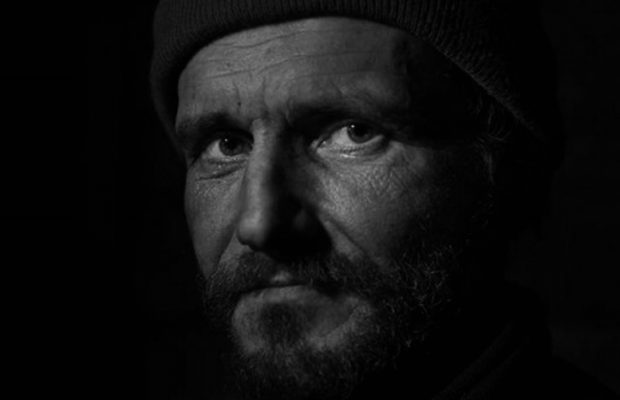
The War
Every week Ukraine Calling reports the number of casualties and injuries from Ukraine’s war zone. This week we’re going to give you names. Names of those killed during the month of March, one of the deadliest months of the war. Serhii Mosiichuk was the youngest, a 20 year old electrician from Korets’ in Rivne oblast. Oleksandr Pedak was the oldest. A 57 year old from Zaporizhzhia. He had been serving since February 2015, and was killed by a mortar shell on March 30th, just 5 days before his 58th birthday. Here are the others, in chronological order of when they died. Volodymyr Pirus, L’viv oblast nom de guerre, ‘the artist.’ Oleksandr Vozniuk, a 20 year old son of a priest from Poltava, who played guitar and wrote poetry in between heavy shelling. Rostyslav Trukhans’kyi, L’viv oblast. Roman Kyianytsia, Kyiv oblast. A month before being killed he wrote this on his social media page: “War is won by those, who instead of seeking employment in the West, chose the hell in the East.” Oleksandr Veremeienko, Luhans’k oblast. Oleksii Rufims’kyi, Dnipropetrovs’k oblast. Called ‘Old Man,’ because he was 50. Mykhailo Myronov, Khakiv oblast. Vitaliy Dzyza, Zaporizhzhia oblast. Serhii Holubiev, Donets’k oblast. Anton Dzeryn, Poltava oblast, nickname Picasso. Sakhib Atakishyiev, Luhans’k oblast. Volodymyr Kniazev, L’viv oblast. Mykola Hrabarchuk, Khmelnyts’k oblast. Mykola Iavors’kyi, Volhyn oblast. Dmytro Kushnir, Dnipro city. Leonid Halaichuk, Odesa oblast. Oleksii Kondratiuk, Rivne oblast. Ihor Iliushko, Zaporizhzhia oblast. Dmytro Poliovyi, Dnipro city. Viacheslav Chernets’kyi, Vinnystia oblast. Ruslan Bondar, Vinnystia oblast. Dmytro Shmatko, Dnipropetrovs’k oblast. Oleksandr Malenko, Dnipropetrovs’k oblast. Volodymyr Pavliv, who had lived in England and Belgium but returned to Ukraine and volunteered when the war began, L’viv oblast. Petro Kozaruk, Ivano-Frankivs’k oblast. Serhii Mosiichuk, Rivne oblast. Oleksii Tymchenko, Cherkassy oblast. Vladyslav Pysarenko, born and raised in Donets’k, his parents remain there. As a 19 year old he volunteered on the Ukrainian side. Killed near Bakhmut. Maksym Narizhnyi, Sumy oblast. Volodymyr Iehorenko, Luhans’k oblast. Anton Vel’mozhko, Zaporizhzhia. Dmytro Sums’kyi, Kyiv. Oleh Novokhat’ko, Cherkassy oblast. Volodymyr Karpalov, Zaporizhzhia oblast. You can see the faces of these men and read more about them in an article in Novynaria (in Ukrainian). We’ll post a link to it on our website.
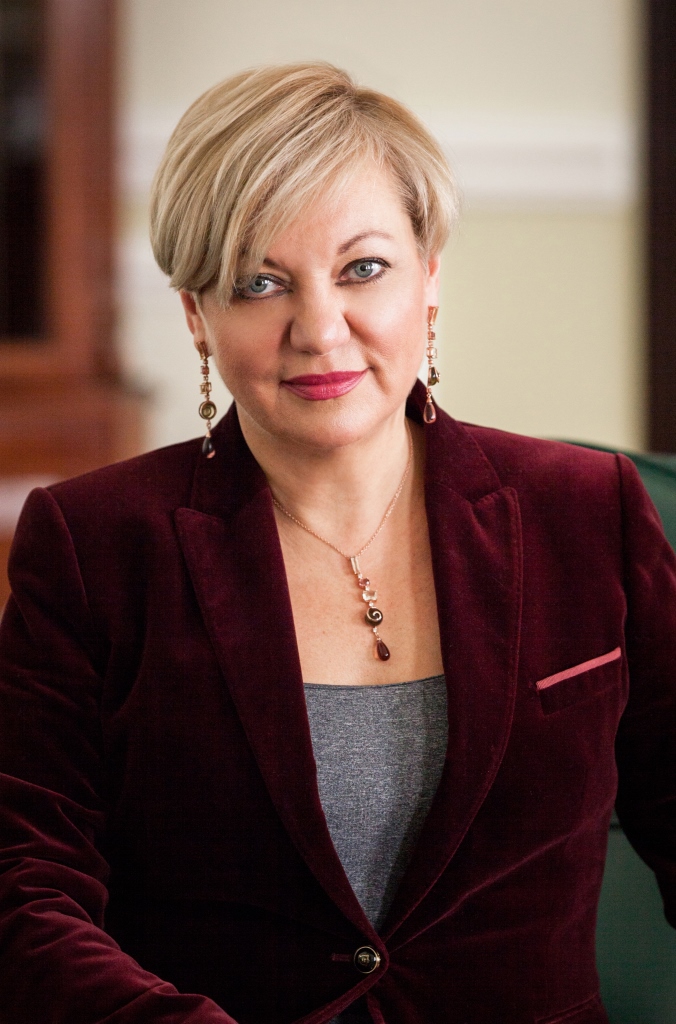
Ukraine’s National Bank Governor Resigned
Ukraine’s National Bank Governor resigned this Monday. Valeria Hontaryeva announced her resignation at a press conference in Kyiv on 10 April. She had signaled that she planned to step down already in March, after the IMF dispersed its latest aid tranche, which is did last week. Hontaryeva was in some ways controversial, but highly praised by international officials for steering Ukraine to stability at a difficult time. She’s a former investment banker and business associate of President Poroshenko. Some accused her of being a Russian stooge, while others hailed her as a strong anti-corruption reformer. Ukraine Calling listeners may remember we reported in December that under her watch, the country’s largest private bank was nationalized when it was on the brink of insolvency. PryvatBank had been owned by one of Ukraine’s richest men, Ihor Kolomoisky. The bank’s problems were caused by what some euphemistically called, «imprudent lending policy,» while others said was part of the problem of an oligarch-owned economy. While heading the Central Bank, Hontaryeva introduced major financial reforms. They included moving to a flexible exchange rate, and cleaning up the banking system by shutting down problematic lenders. According to the IMF’s forecast, Ukraine’s economy is poised to grow by 2% this year. But some were unhappy with the Bank Governor. Protesters had left a coffin with her head in it on the Bank’s doorstep, in what was seen as a death threat. Hontaryeva’s resignation is due to go into effect in May. President Poroshenko has until then to find a replacement.
Government Proposes to Get Rid of Soviet Era Legislation
Ukraine’s government, called the Cabinet of Ministers, wants the country to move beyond its communist past in a legal way. On Wednesday Justice Minister Pavlo Petrenko’s draft Law was approved. It calls for all Soviet era legislation to be suspended, and replaced by new laws reflect the country’s present. This process has been occurring in a piecemeal fashion since the country declared independence in 1991. Now the Justice Minister proposes to make it systematic. The Law will be sent to Parliament for consideration. If passed, it will eliminate legal anachronisms that are still on the books. Such as the 1923 Commissariat of Labour Decree that lists the categories of civil servants who are to receive 400 grams of extra soap supplies to supplement the soap found in the workplace.
Easter celebrations were never formally outlawed in the Soviet era, since the state formally guaranteed freedom of religion. However, in practice, religious believers were discriminated against and attacked. This is something that changed in the late 1980s during the glasnost years. Since independence, these holidays have enjoyed a revival. And that’s what this week’s feature interview is about.
CULTURE
Something that has really taken off in the arts and become popular in recent years is the outdoor city-sponsored festival. It is usually financed with the help of corporate sponsors and provides a platform for a whole range of artists and involves the whole community. At the moment there’s a Pysanka Festival on one of Kyiv’s most charming squares. St Sophia Square has been turned into a large art installation, consisting of walkways and over 500 large Easter eggs, each one almost a metre tall. 585 artists have decorated them in a variety of media, some in traditional regional patterns, many as individual art installations in themselves and, and some designed by children. There is a tent with Easter-themed ice sculptures. There are areas to try pysanka-making workshops, stands where you can purchase traditional eggs and an Easter market where you can buy your Easter foods. The Festival is in its seventh year, and judging by the fact that it expands each year to include even more events and participants, it is a hit with Kyivites and visitors.
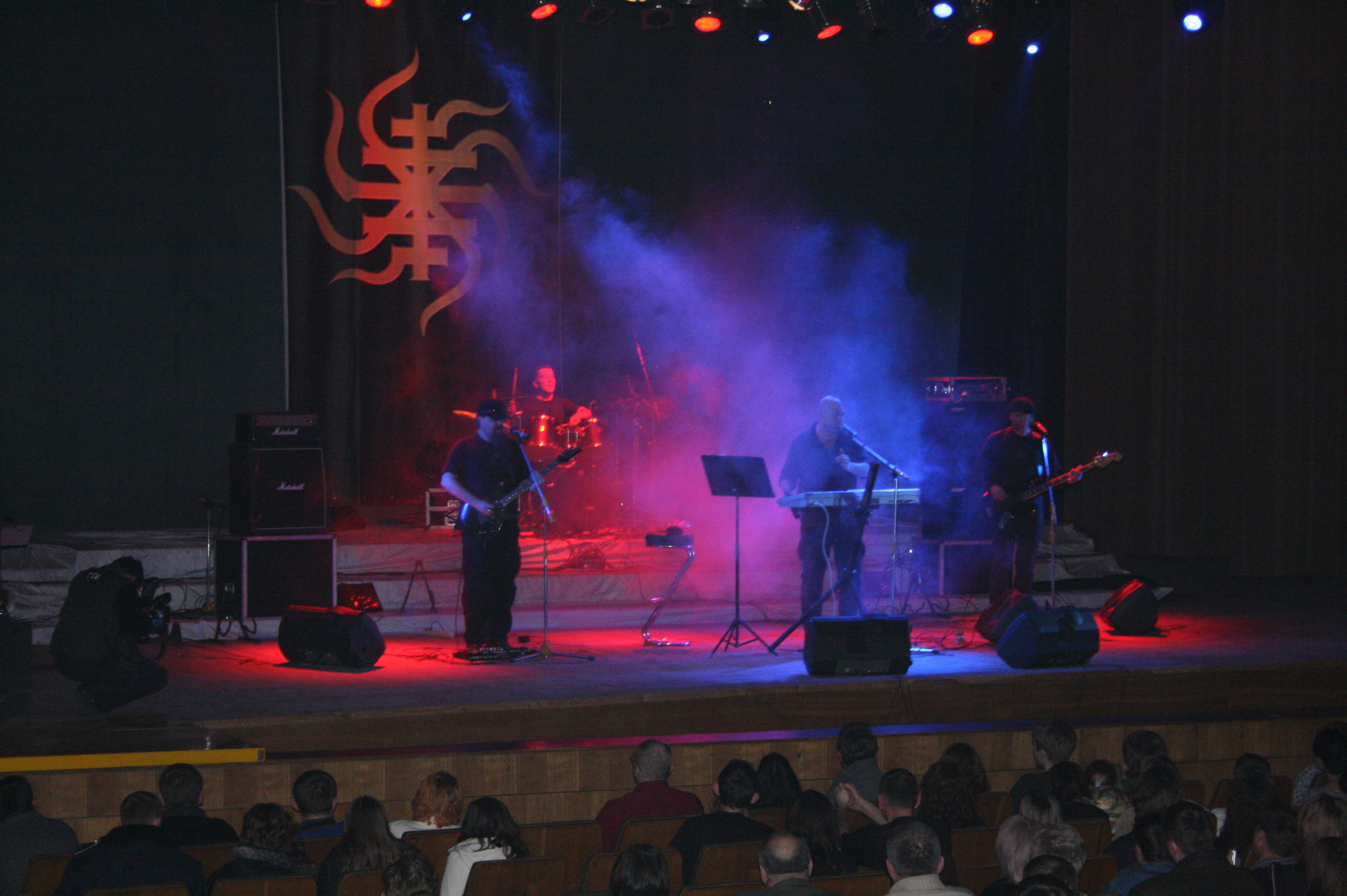
MUSIC
Hi, I’m Andriy Izdryk, sound engineer and I have the pleasure of introducing this week’s song. The legendry Ukrainian rock band Komu Vnyz have a powerful contemporary song about Easter. It’s called Navs’kyi Velykden’, which is the Thursday before Easter. A day that in Ukraine has deep traditions going back to the pagan times. Enjoy!
LOOKING FORWARD
Next week we’ll have a feature interview with Brian Whitmore, a top analyst on Russia and Ukraine. We’ll ask him how changing relations between Russia and the US may affect Ukraine and its neighbours. We’ll be following the headlines for you, as always. Tune in for a new episode. And we’d love to hear from you. Write to us at [email protected]. From the entire Ukraine Calling team, wishing everyone who will be celebrating this weekend, happy holidays! I’m Oksana Smerechuk for Hromadske Radio in Kyiv. Thanks for listening.
Interview transcribed by Larysa Iarovenko, Ilona Szieventsev, and Nykole King. Headlines and Culture by Oksana Smerechuk and Marta Dyczok. Music selected by Marta Dyczok. Sound engineer Andriy Izdryk. Web support Kyrylo Loukerenko.


